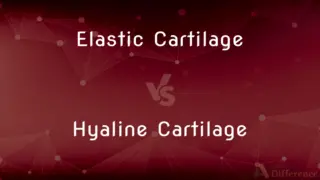Sol Solution vs. Suspension — What's the Difference?
By Maham Liaqat & Fiza Rafique — Published on March 25, 2024
Sol solution is a colloidal system with solid particles dispersed in a liquid, exhibiting stability and uniformity, whereas a suspension contains larger particles that may settle upon standing, showing heterogeneity.

Difference Between Sol Solution and Suspension
Table of Contents
ADVERTISEMENT
Key Differences
Sol solutions are characterized by their small particle size, typically in the range of 1 to 1000 nanometers, which allows them to remain evenly distributed within the dispersing medium without settling. These particles are stable due to their interaction with the solvent, which prevents them from aggregating. On the other hand, suspensions consist of larger particles, often exceeding 1000 nanometers, which are not stable in the dispersing medium. As a result, these particles tend to settle out over time due to gravity, leading to a lack of uniformity in the mixture.
The stability of sol solutions is attributed to the phenomenon of Brownian motion, where the continuous movement of particles prevents them from settling. This motion is a result of collisions with solvent molecules, which keeps the dispersed phase uniformly distributed. Whereas, in suspensions, the particles are too large to be significantly affected by Brownian motion, leading to their eventual settlement at the bottom of the container if left undisturbed.
Sol solutions exhibit Tyndall effect, a phenomenon where light is scattered by the particles in the colloidal solution, making a beam of light visible when passed through it. This effect is indicative of the stable dispersion of particles within the solvent. In contrast, while suspensions may also scatter light, the effect is often less pronounced due to the larger size and lower stability of the particles, which can lead to a more opaque appearance.
The preparation of sol solutions often involves methods that ensure the reduction of particle size to the colloidal range, such as condensation or dispersion techniques, which aim to achieve the desired stability and homogeneity. Suspensions, however, can be prepared simply by mixing the solute and solvent without the need for specialized processes to maintain particle size, as the system is inherently unstable and heterogenous.
Sol solutions are often transparent or translucent due to the small size of the dispersed particles, which do not scatter light significantly to affect transparency. Suspensions, on the other hand, tend to be opaque or have a cloudy appearance because the larger particles scatter light more effectively, reducing the transparency of the mixture.
ADVERTISEMENT
Comparison Chart
Particle Size
1 to 1000 nm
>1000 nm
Stability
Stable, particles do not settle
Unstable, particles may settle
Brownian Motion
Significant, prevents settling
Insignificant, allows settling
Tyndall Effect
Pronounced, due to stable dispersion
Less pronounced or varied
Appearance
Transparent or translucent
Opaque or cloudy
Compare with Definitions
Sol Solution
Shows Tyndall effect when light passes through.
The beam of light visible in a foggy room demonstrates the Tyndall effect in sol solutions.
Suspension
A heterogeneous mixture with larger particles that may settle.
Sand in water forms a suspension that separates over time.
Sol Solution
Characterized by small particle size.
Detergents form sol solutions that efficiently clean surfaces.
Suspension
Particles settle due to gravity.
Orange juice with pulp needs to be shaken as the pulp forms a suspension.
Sol Solution
Prepared by condensation or dispersion methods.
Industrial sol solutions are often prepared using high-energy milling processes.
Suspension
May scatter light, resulting in a cloudy appearance.
Flour in water forms a cloudy suspension that obscures light.
Sol Solution
A stable colloidal mixture with solid particles in a liquid.
Ink is a sol solution used in writing and printing.
Suspension
Simple mixing is often sufficient for preparation.
Making a suspension of chalk in water involves just stirring.
Sol Solution
Exhibits uniform distribution without settling.
Paint is a sol solution that remains consistent over time.
Suspension
Larger particle size compared to sol solutions.
Medicinal suspensions often require stirring before use.
Suspension
(Chemistry) A system in which minute particles are dispersed throughout a fluid from which they are easily filtered but not easily settled because of system viscosity or molecular interactions.
Suspension
The state of a solid or substance produced when its particles are mixed with, but not dissolved in, a fluid, and are capable of separation by straining.
Suspension
The state of a solid when its particles are mixed with, but undissolved in, a fluid, and are capable of separation by straining; also, any substance in this state.
Suspension
A mixture in which fine particles are suspended in a fluid where they are supported by buoyancy
Common Curiosities
How do suspensions differ from sol solutions in terms of stability?
Suspensions are less stable and tend to have particles that settle upon standing, unlike sol solutions.
Can the Tyndall effect be observed in both sol solutions and suspensions?
Yes, but it is more pronounced in sol solutions due to their stable colloidal nature.
What causes particles in a suspension to settle?
Gravity causes the larger particles in suspensions to settle due to their size and weight.
What defines a sol solution?
A sol solution is defined by its stable, uniform dispersion of small particles within a liquid.
Are sol solutions and suspensions prepared differently?
Yes, sol solutions often require specific preparation methods to achieve colloidal size, while suspensions can be made by simple mixing.
Can the particle size in sol solutions and suspensions be altered?
Yes, through various chemical and physical processes, but this changes their classification and properties.
Why do sol solutions remain transparent?
The small particle size in sol solutions does not significantly scatter light, maintaining their transparency.
What role does Brownian motion play in sol solutions?
Brownian motion keeps the particles in sol solutions from settling, ensuring their stability.
How is the particle size relevant in distinguishing between sol solutions and suspensions?
Sol solutions have particles sized 1 to 1000 nm, whereas suspensions have particles larger than 1000 nm.
Can suspensions become clear over time?
Suspensions may become clear as particles settle, leaving the liquid phase clear.
Why are suspensions considered heterogeneous?
Because their composition is not uniform throughout, due to particle settling.
How does the appearance of a sol solution compare to a suspension?
Sol solutions are generally transparent or translucent, whereas suspensions are opaque or cloudy.
Are all colloidal solutions sol solutions?
Yes, sol solutions are a type of colloidal system with solid particles dispersed in a liquid.
Is the Tyndall effect a reliable way to identify a sol solution?
It's indicative but not solely reliable, as other factors like concentration and particle size also influence visibility.
What practical applications do sol solutions have?
They are widely used in inks, paints, and pharmaceuticals due to their stability and uniformity.
Share Your Discovery

Previous Comparison
Elastic Cartilage vs. Hyaline Cartilage
Next Comparison
Travel Agent vs. Tour OperatorAuthor Spotlight
Written by
Maham LiaqatCo-written by
Fiza RafiqueFiza Rafique is a skilled content writer at AskDifference.com, where she meticulously refines and enhances written pieces. Drawing from her vast editorial expertise, Fiza ensures clarity, accuracy, and precision in every article. Passionate about language, she continually seeks to elevate the quality of content for readers worldwide.













































